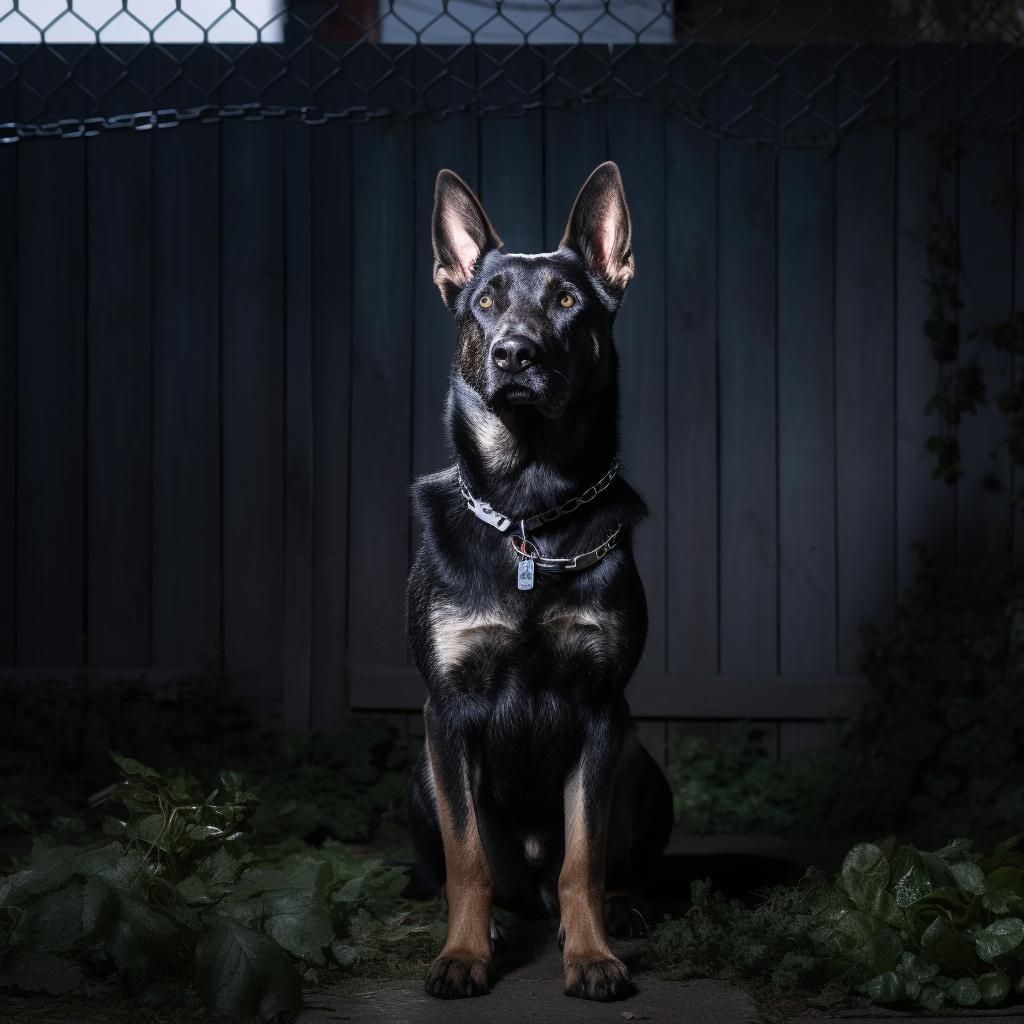Understanding Territorial Aggression
Territorial aggression is a common behavioral problem in dogs. It's an instinctive way of protecting their space and exhibiting dominance. Dog owners must recognize the root cause and know how to manage it. Some of the causes may include fear, anxiety, lack of socialization, or past traumas. Signs of aggression include barking, growling, biting, guarding resources, and raised fur.
Exercising, training, and discipline can help you and your dog. But, sometimes, professional help is needed. I had a German Shepherd called Max who exhibited this behavior. We used desensitization techniques recommended by a certified dog trainer. Through patience, rewards, and consistent training sessions, Max was able to overcome his aggression.
Remember, understanding the cause is essential for managing the behavior. But how to use shock collar for territorial aggression is a question.
Assessing the Need for a Shock Collar


It's essential to assess the need for a shock collar for territorial aggression. This means evaluating the severity, exploring alternative methods, and consulting with professionals. Here are factors to consider:
- Severity: See how bad and frequent your dogs' aggressive behavior is. If it's serious, look for immediate solutions.
- Training Methods: Assess how successful the training was in addressing the aggression. If unsuccessful, explore other options.
- Consult Professionals: Talk to an animal behaviorist or a professional dog trainer who focuses on territorial aggression. They can provide insight into the causes of your pup's behavior and recommend suitable training.
- Medical Exam: Rule out any medical issues that may contribute to the aggression. A vet can help identify or rule out physical conditions that may be making your pup aggressive.
- Countercondition and Desensitize: Use these approaches to expose your pup to situations that trigger aggression and reinforce positive responses. Consistency helps reduce aggression.
- Positive Reinforcement Training: Use positive reinforcement-based training instead of punishment-based approaches. Reward desired behaviors with treats, praise, and playtime.
Remember, use a shock collar as a last resort and only with close supervision from an expert. Your pup's well-being should always come first.
Choosing the Right Shock Collar
To address the issue of choosing the right shock collar for territorial aggression, delve into the diverse range of shock collar types available. Explore different types of shock collars, to find an appropriate solution for your specific training needs.
Different Types of Shock Collars
Shock collars come in many types, each with its own features & benefits. Let's explore them!
Static shock collars deliver harmless static shocks for excessive barking or jumping. These can be adjusted to suit your pup's sensitivity.
Vibration collars use vibrations instead of shocks.
Spray collars release citronella spray.
Ultrasonic collars emit high-frequency sound waves only dogs can hear.
When selecting a shock collar, consider your pet's temperament, size, and training needs. Consult a professional trainer or behaviorist who can provide personalized advice. Shock collars should always be used responsibly & as a last resort. Understand the different types & choose the most suitable one for your pup!
How To Use Shock Collar for Territorial Aggression
To ensure the effective use of the shock collar for territorial aggression, equip yourself with the knowledge of setting it up correctly. Proper fitting of the collar and adjusting the intensity levels are crucial sub-sections that will be discussed to provide you with the best solutions for using the collar and addressing territorial aggression in your pet.
Proper Fitting of the Collar
- Measure their neck. Use a soft tape measure to get the circumference.
- Adjust the strap. Slide the strap over your dog's head and make sure it fits snugly.
- Check positioning. Make sure the contact points are centered under their throat, behind their ears.
- Test the fit. Pull on the leash or activate a low-intensity stimulation and make sure the collar doesn't restrict movement.
- Monitor & recheck. As your pup grows or changes weight, regularly check that the collar still fits them properly.
Adjusting the Intensity Levels
To make sure your shock collar works best, you need to adjust its intensity levels. This not only keeps your dog safe but also lets you customize it for their specific needs. Start low and observe their reaction – look for signs of distress. Gradually increase intensity while monitoring. Take individual variability into account – each pet may be different. Remember that every pet is unique and needs time to understand its behavior.
Training Techniques with the Shock Collar
To effectively train your dog for territorial aggression, utilize training techniques with the shock collar. Employ both positive reinforcement and negative reinforcement methods to address this behavior and promote desired outcomes.
Positive Reinforcement
Positive reinforcement is a great way to train animals. Rewards like treats, praise, toys, and clicker training with a distinctive sound are utilized to reinforce desired behavior. Timing is important, as trainers should provide the reward immediately after the desired action is completed. Consistency is also key to ensuring the dog is not confused. This technique can be used for dogs of all ages and breeds.
Understandably, using positive reinforcement needs to be done consistently and promptly. This will foster learning and create a strong bond between the trainer and the dog. To get the most out of this method, trainers should set clear goals and expectations, break down behaviors into smaller steps, use high-value rewards, and vary the type of rewards. These suggestions help optimize the use of positive reinforcement techniques.
Negative Reinforcement
Shock collars for negative reinforcement can be controversial. But, when used correctly, they can teach a pup to link undesired behavior with an unpleasant feeling.
Negative reinforcement uses electric shocks on a dog's neck when they do something bad. This helps them avoid this bad behavior due to the discomfort it creates.
It's vital to use the correct intensity and make sure the timing of the shock is precise. Consistency and proper training are a must for negative reinforcement.
Pro Tip: Always seek advice from a professional dog trainer before using negative reinforcement techniques. They can show you how to properly use the shock collar and ensure your pup's safety during training.
Implementing the Shock Collar for Territorial Aggression
To address territorial aggression in your dog, effectively implement the shock collar by focusing on two key aspects: identifying trigger situations and maintaining consistency and timing of corrections. By understanding the unique circumstances that provoke aggression and applying corrections consistently and at the right moment, you can successfully curb your dog's territorial behavior.
Identifying Trigger Situations
When using a shock collar to address territorial aggression, it's vital to recognize the triggers. Follow these 3 steps:
- Watch behavior. Notice signs of stress, fear, or aggression such as barking, growling, or aggressive postures.
- Log incidents. Note the specific triggers that set off aggression, e.g. strangers or other animals near their territory.
- Analyze. Look for patterns or the same stimuli that provoke aggression in your dog.
Every dog is different, so understanding triggers is key to managing territorial aggression. Tom had a German Shepherd called Buddy with this issue. By observing Max and logging incidents, he found that unfamiliar people approaching the front gate caused Max to act aggressively. Armed with this info, Tom used training alongside the shock collar to manage Max's aggression.
Consistency and Timing of Corrections
For successful shock collar use when dealing with territorial aggression, consistency, and timing are essential. Here are five points to keep in mind:
- Consistency: Apply corrections every single time your pup displays aggression. This will help them understand that this behavior is wrong.
- Timing: Deliver the correction at the exact moment they display aggressive behavior. This way, they can associate their action with the collar's discomfort.
- Reinforcement: Reinforce the effect of corrections with verbal cues or commands. This will help them connect their behavior with consequences.
- Gradual Intensity: Start low and gradually increase the intensity if needed. This allows for humane training and inflicts minimal discomfort on the dog.
- Positive Reinforcement: Provide rewards for desired behaviors too. This balances corrections and makes it easier for dogs to differentiate between good and bad behavior.
Safeguarding the Well-being of Your Dog
To safeguard the well-being of your dog when dealing with territorial aggression, consult a professional trainer to obtain guidance and support. Additionally, ensure the responsible usage of the shock collar by closely monitoring its use. This two-fold approach will contribute to addressing the issue effectively and prioritizing your dog's welfare.
Consulting with a Professional Trainer
- Visit a pro trainer in your area.
- Have a consultation to discuss your pup's needs and wants.
- Tell the trainer about any issues you're dealing with.
- The trainer will make a plan just for your dog.
- Follow the exercises and appointments with the trainer.
- Pro trainers are super knowledgeable on behavior, body language, and psychology.
- They use positive reinforcement to make trust and understanding stronger.
- Participate in the training process and be consistent.
- Progress takes time, so be patient.
- You'll learn more about your pup and create a strong bond.
Monitoring the Collar's Usage
To keep your furry comrade safe and content, keeping an eye on their collar is key! Monitor its use closely to ensure their well-being.
Check the fitting – it should be snug but not too tight. Also, use gentle yet durable material to avoid skin irritation. Clean it regularly to avoid bacteria growth and bad smells. Plus, limit wear time to prevent chafing and soreness.
Look out for fraying and lose fittings, and upgrade the collar as they grow. Taking proactive steps will ensure a comfortable experience for them.
Research shows that dogs with appropriate collars have improved mobility and are much happier! So, take the necessary steps to monitor your dog's collar usage diligently and prioritize their needs.
Alternatives to Shock Collars
When it comes to dealing with territorial aggression in pets, shock collars aren't the only option. Here are six alternatives:
- Positive Reinforcement Training: Rewarding good behavior and ignoring negative behavior.
- Desensitization and Counter-Conditioning: Exposing the pet to triggers that provoke aggression while providing positive experiences.
- Behavioral Modification: Working with a professional to identify and address the underlying causes of aggression.
- Medication: To manage anxiety or aggression.
- Adequate Exercise: To alleviate stress and reduce aggression.
- Environmental Enrichment: Providing toys, games, and mental stimulation.
Plus, each pet is unique, so finding the right alternative may require trial and error. Professional guidance can help increase the chances of success.
Conclusion
Ultimately, when it comes to territorial aggression, shock collars can be effective when used responsibly. It is key to comprehend the cause of the aggression and fix it through training and behavior modification. The collar should be seen as one part of a bigger approach – which must include positive reinforcement and professional assistance.
When using a shock collar, it is vital to adhere to the manufacturer's instructions. Setting the right level of stimulation and ensuring a correct fit is essential for your dog's safety and welfare. Positive reinforcement should be used alongside the collar, rewarding desirable habits to strengthen good behaviors.
To conclude, shock collars for territorial aggression need responsible use and integration into a complete behavioral modification program. By combining positive reinforcement techniques, professional advice, and environmental management strategies, you can work towards resolving your dog's territorial aggression issues in a humane way.
Frequently Asked Questions
How does a shock collar work for territorial aggression?
A shock collar emits a small electric shock to your dog when they exhibit territorial aggression. It serves as a deterrent to help them understand that their behavior is unacceptable.
Is it safe to use a shock collar for territorial aggression?
When used correctly, a shock collar for territorial aggression is safe for both dogs and humans. However, it is important to understand the proper way to use it to avoid negatively impacting your dog's behavior.
Can a shock collar completely stop a dog's territorial aggression?
A shock collar may help in reducing territorial aggression, but it is not a guarantee that it will completely stop it. Sometimes, other training methods need to be used in combination with a shock collar to achieve desired results.
How long should a shock collar be used for territorial aggression?
A: The length of time a shock collar should be used for territorial aggression depends on your individual dog and its behavior. Typically, a shock collar is used until the desired behavior is achieved, and then it is gradually phased out over time.
Can shock collars be used for every type of dog?
No, shock collars are not appropriate for every type of dog. Dogs with pre-existing medical conditions, behavior issues, or anxiety may not be good candidates for a shock collar. It is best to consult with a veterinarian or professional dog trainer to determine if a shock collar is suitable for your dog.
What are the alternatives to using a shock collar for territorial aggression?
There are several alternatives to using a shock collar for territorial aggression, including behavior modification training, positive reinforcement training, and environmental management. These methods can be effective without resorting to using a shock collar.





